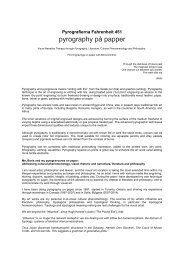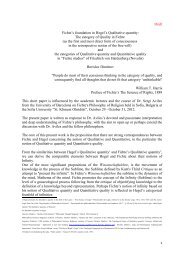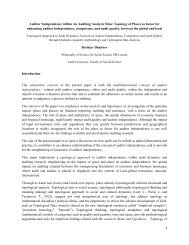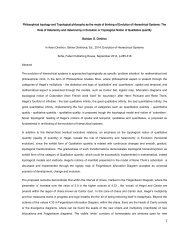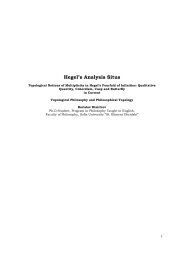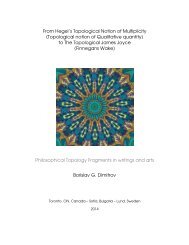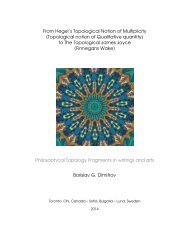Topological Ontology and Logic of Qualitative quantity
Qualitative quantity and BFO (Basic Formal Ontology) of /Barry Smith/ and YAMATO (Yet Another More Advanced Top-level Ontology) of /Riichiro Mizoguchi/
Qualitative quantity and BFO (Basic Formal Ontology) of /Barry Smith/ and YAMATO (Yet Another More Advanced Top-level Ontology) of /Riichiro Mizoguchi/
- No tags were found...
You also want an ePaper? Increase the reach of your titles
YUMPU automatically turns print PDFs into web optimized ePapers that Google loves.
The roots <strong>of</strong> Hegel’s <strong>Qualitative</strong> <strong>quantity</strong> <strong>and</strong> the presence <strong>of</strong> the modern category <strong>of</strong><br />
<strong>Qualitative</strong> <strong>quantity</strong> can be unfolded in the works <strong>of</strong> Charles S<strong>and</strong>ers Peirce. Peirce arrived<br />
at his own system <strong>of</strong> three categories after a thoroughgoing study <strong>of</strong> his predecessors, with<br />
special reference to the categories <strong>of</strong> Aristotle, Kant, <strong>and</strong> Hegel. The names that Peirce used<br />
for his own categories varied with context <strong>and</strong> occasion, but ranged from reasonably<br />
intuitive terms like quality, reaction, <strong>and</strong> representation to maximally abstract terms like<br />
firstness, secondness, <strong>and</strong> thirdness, respectively.<br />
The influence <strong>of</strong> German tradition <strong>and</strong> especially <strong>of</strong> Hegel in Peirce categorical system is<br />
widly recognized. 67 The prevalence in Peirce’s thinking <strong>of</strong> Kantian <strong>and</strong> Hegelian resources<br />
are well illustrated in his early essay “On a New List <strong>of</strong> Categories”. Peirce’s argument here<br />
patently draws on Kantian concepts <strong>of</strong> categorial analysis as a means <strong>of</strong> distinguishing<br />
ontological realms, although the categories he proposes, here denominated Quality,<br />
Relation, <strong>and</strong> Representation, are <strong>of</strong> very different character from Kant’s. Instead, this triadic<br />
scheme <strong>of</strong> categories seems clearly, if roughly, correlate with the three movements <strong>of</strong> the<br />
Hegelian dialectic (considered as Being, Negation, <strong>and</strong> Mediation); in later formulations,<br />
Peirce even identifies his third category (in one <strong>of</strong> its aspects) with mediation (e.g., EP<br />
2.183, in the fourth Harvard Lecture [1903]).<br />
The category <strong>of</strong> <strong>Qualitative</strong> <strong>quantity</strong> is a sign, a sign <strong>of</strong> gradualness, a topological sign. The<br />
aspects <strong>of</strong> the <strong>Qualitative</strong> <strong>quantity</strong> involve not the dyadic relations typical for the physical<br />
sciences, but the triadic relations <strong>of</strong> the semiotic sciences. The interplay <strong>of</strong> qualitative<br />
<strong>and</strong>quantitative in the qualitative <strong>quantity</strong> is the interplay <strong>of</strong> the predicates <strong>of</strong> predicates.<br />
As Peirce asserted:<br />
“I will now say a few words about what you have called Categories, but for which I prefer<br />
the designation Predicaments, <strong>and</strong> which you have explained as predicates <strong>of</strong> predicates.” 68<br />
I will direct to the <strong>Qualitative</strong> <strong>quantity</strong> with the known Peirce’s expression – “That<br />
wonderful operation <strong>of</strong> hypostatic abstraction”:<br />
“That wonderful operation <strong>of</strong> hypostatic abstraction by which we seem to create entia<br />
rationis that are, nevertheless, sometimes real, furnishes us the means <strong>of</strong> turning predicates<br />
from being signs that we think or think through, into being subjects thought <strong>of</strong>. We thus<br />
think <strong>of</strong> the thought-sign itself, making it the object <strong>of</strong> another thought-sign.” 69<br />
66 Arnold Johanson, "Modern Topology <strong>and</strong> Peirce's Theory <strong>of</strong> the Continuum", Transactions <strong>of</strong> the Charles S.<br />
Peirce Society, Vol.37, No..1, Indiana University Press, 2001,pp.1-12<br />
http://www.jstor.org/pss/40320822<br />
67 See: Richard S. Beth, “On the Recent German reception <strong>of</strong> Peirce, with emphasis on Habermas”,<br />
Congressional Research Service (U.S.A.), paper prepared for delivery at the Sixth Pan-European International<br />
Relations Conference <strong>of</strong> the St<strong>and</strong>ing Group on International Relations <strong>of</strong> the European Consortium for<br />
Political Research, Turin, Italy, September 12-15, 2007<br />
68 Charles S<strong>and</strong>ers Peirce, p. 522, "Prolegomena to an Apology for Pragmaticism", The Monist, vol.XVI, no.4,<br />
Oct. 1906, pp. 492-546, reprinted in the Collected Papers vol 4, paragraphs 530–572, see paragraph 549.<br />
69 Charles S<strong>and</strong>ers Peirce, p. 522, "Prolegomena to an Apology for Pragmaticism", The Monist, vol.XVI, no.4,<br />
Oct. 1906, pp. 492-546, reprinted in the Collected Papers vol 4, paragraphs 530–572, see paragraph 549.<br />
33





